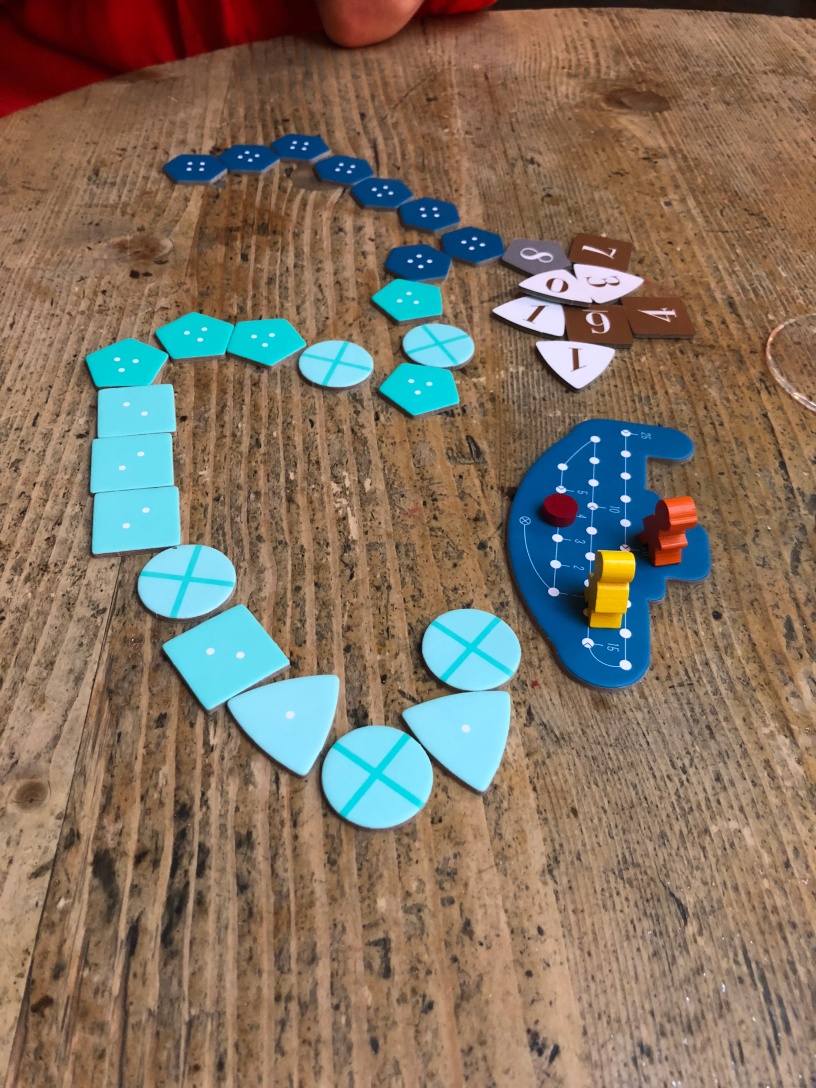Type: Push your Luck
Time to play: 20 minutes (Teaching: 5 minutes)
Best played with: 3 Player (2 – 6 Players)
Roll, move, roll, move. This is the starting point for many well known, much played board games. It’s a mechanic often associated with these snakes and ladders / monopoly historic games. However, as Deep Sea Adventure proves this mechanic can have more to it and still attract more new gamers to the hobby!
This little game, with it’s distinctive box is a great intro game for new players who want light, quick to learn games that are easily repeatable and play to high player counts. The game builds that roll and move mechanic into a simple push your luck game where each player races out into the depths of the sea and gathers treasure before returning home. Returning home is not so simple though – the more you gather the slower you move and the more oxygen you use.
The real trick of this game though is that the oxygen tank is shared. A resource that depletes each round based on your actions, but where the choices of other players limit your choices and where sometimes killing all players may be your optimal choice. Why? Because sometimes you are in a bad position relative to others and the best thing you can do is pick up more resources to run down the tank.
This part of the game – that a player too far in the lead on any given round might reverse the incentives of other players – is probably why I think this game is so compelling with simple rules. You all want treasure and you all want to get back, but if one guy has 3 and you only have 1 then you probably don’t want him to get back more than you care about getting back.
So try to get ahead but not too far ahead. Easier said than done as all the treasure starts face down and stays face down until you get back to the ship. You cannot tell what you have taken, just how much you are carrying. What’s more the treasure is split into four value groups (the most valuable being the furthest into the depths). This adds to the difficulty because it means that at the start of the game you want to go out as far as you can (while Oxygen is easy). However, you want to be the first player to turn back to give you the best chance of making it back to the sub. These two little conflicting factors make you push your luck (diving further) until you can stand it no more, or until your opponent has turned back and you need to rush to catch them up.
So how deep should you dive? How much should you carry? If you take more, and hence use the oxygen will the opponent still make it back? These are the questions you are trying in each round. Plus, you get three rounds to work it out before the points calculators come out and you total up your treasure. Scoring between rounds lets you know who is leading and again varies the incentives between the players.
However, this is obviously a roll and move, and whilst both dice have two sides that say “1”, two “2”s and two “3”s to reduce dispersion this does not remove luck. You are more likely than on a single 6 sided dice to roll a 3 or 4, but these small differences can have a huge impact on your game (especially when you do roll a 6).
This then is quite a luck based game. You can have a plan, but you are tactically adapting to your roles. Each time you role could be the opportunity to take more treasure or the need to drop some!
The more players in the game, the more players to keep an eye on and see who breaks first / how much oxygen is left and how much treasure everyone has. Lot’s to think about for such a small box game. Oh, and for those who want to introduce non-gamers to the hobby this was a huge hit with my other half!
Last notes,
- If you like a fast paced filler to start or end the night – roll and move
- If you hate heavy luck games – there is nothing you can do to avoid it here
- If you win, try again and with more players
